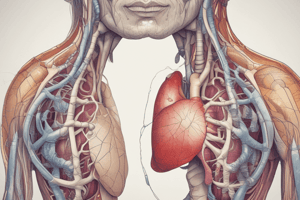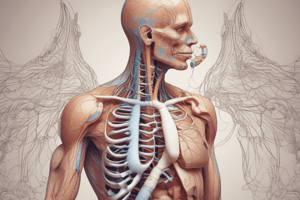Podcast
Questions and Answers
The respiratory system is responsible for keeping the body supplied with carbon dioxide.
The respiratory system is responsible for keeping the body supplied with carbon dioxide.
False (B)
The respiratory system includes organs that purify, humidify, and warm incoming air.
The respiratory system includes organs that purify, humidify, and warm incoming air.
True (A)
The lungs, pharynx, and trachea are all part of the respiratory system.
The lungs, pharynx, and trachea are all part of the respiratory system.
True (A)
The main function of the respiratory system is to oversee the gas exchange that occurs between the stomach and the external environment.
The main function of the respiratory system is to oversee the gas exchange that occurs between the stomach and the external environment.
The alveoli are found in the bronchi, which are part of the respiratory system.
The alveoli are found in the bronchi, which are part of the respiratory system.
The pharynx is approximately 13 cm (5 inches) long.
The pharynx is approximately 13 cm (5 inches) long.
The nasopharynx is the inferior portion of the pharynx.
The nasopharynx is the inferior portion of the pharynx.
The pharyngotympanic tubes, which drain the middle ear, open into the oropharynx.
The pharyngotympanic tubes, which drain the middle ear, open into the oropharynx.
The palatine tonsils are located in the nasopharynx.
The palatine tonsils are located in the nasopharynx.
The lingual tonsils lie at the base of the tongue.
The lingual tonsils lie at the base of the tongue.
The larynx is directly superior to the pharynx.
The larynx is directly superior to the pharynx.
The thyroid cartilage is commonly referred to as Adam's apple.
The thyroid cartilage is commonly referred to as Adam's apple.
The vocal folds are part of the mucous membrane of the larynx and help produce sound.
The vocal folds are part of the mucous membrane of the larynx and help produce sound.
The glottis is the spoon-shaped flap of elastic cartilage in the larynx.
The glottis is the spoon-shaped flap of elastic cartilage in the larynx.
The trachea is approximately 10 to 12 cm in length.
The trachea is approximately 10 to 12 cm in length.
The trachea's walls are reinforced with O-shaped rings of hyaline cartilage.
The trachea's walls are reinforced with O-shaped rings of hyaline cartilage.
The right main bronchus is narrower, longer, and more curved than the left.
The right main bronchus is narrower, longer, and more curved than the left.
The lungs occupy the entire thoracic cavity including the mediastinum.
The lungs occupy the entire thoracic cavity including the mediastinum.
The left lung is divided into three lobes by fissures.
The left lung is divided into three lobes by fissures.
The apex of each lung is located just deep into the clavicle.
The apex of each lung is located just deep into the clavicle.
The walls of the thoracic cavity are lined with the parietal pleura.
The walls of the thoracic cavity are lined with the parietal pleura.
Both the right and left main bronchi are formed by the division of the esophagus.
Both the right and left main bronchi are formed by the division of the esophagus.
The nostrils, also known as nares, are the entry points for air during breathing.
The nostrils, also known as nares, are the entry points for air during breathing.
Olfactory receptors are located in the mucosa of the inferior part of the nasal cavity, just beneath the sphenoid bone.
Olfactory receptors are located in the mucosa of the inferior part of the nasal cavity, just beneath the sphenoid bone.
The respiratory mucosa of the nasal cavity rests on a rich network of thin-walled veins that warm the air as it flows past.
The respiratory mucosa of the nasal cavity rests on a rich network of thin-walled veins that warm the air as it flows past.
Ciliated cells in the nasal mucosa create a gentle current that moves mucus anteriorly towards the nose, to be expelled.
Ciliated cells in the nasal mucosa create a gentle current that moves mucus anteriorly towards the nose, to be expelled.
The conchae in the nasal cavity help increase the surface area of the mucosa exposed to the air.
The conchae in the nasal cavity help increase the surface area of the mucosa exposed to the air.
The palate that separates the nasal cavity from the oral cavity consists of an anterior bony part called the hard palate and an unsupported posterior part called the soft palate.
The palate that separates the nasal cavity from the oral cavity consists of an anterior bony part called the hard palate and an unsupported posterior part called the soft palate.
The paranasal sinuses are found only in the frontal and maxillary bones.
The paranasal sinuses are found only in the frontal and maxillary bones.
Lysozyme enzymes in the mucus destroy bacteria chemically.
Lysozyme enzymes in the mucus destroy bacteria chemically.
The respiratory membrane is constructed solely from the alveolar and capillary walls.
The respiratory membrane is constructed solely from the alveolar and capillary walls.
Alveolar macrophages are sometimes referred to as 'dust cells'.
Alveolar macrophages are sometimes referred to as 'dust cells'.
Stroma primarily consists of muscle tissue that aids the lungs in expanding during inhalation.
Stroma primarily consists of muscle tissue that aids the lungs in expanding during inhalation.
Cuboidal cells in the alveoli produce a lipid molecule called surfactant.
Cuboidal cells in the alveoli produce a lipid molecule called surfactant.
The walls of the alveoli are composed mainly of a single, thick layer of cuboidal cells.
The walls of the alveoli are composed mainly of a single, thick layer of cuboidal cells.
Alveolar pores provide alternative routes for air to reach alveoli whose feeder bronchioles have been clogged by mucus or otherwise blocked.
Alveolar pores provide alternative routes for air to reach alveoli whose feeder bronchioles have been clogged by mucus or otherwise blocked.
Pleural fluid allows the lungs to glide easily over the thorax wall during breathing.
Pleural fluid allows the lungs to glide easily over the thorax wall during breathing.
The pleural space is an actual large space between the lungs and the thorax wall.
The pleural space is an actual large space between the lungs and the thorax wall.
Bronchioles are the largest of the conducting passageways.
Bronchioles are the largest of the conducting passageways.
Respiratory zone structures include respiratory bronchioles, alveolar ducts, alveolar sacs, and alveoli.
Respiratory zone structures include respiratory bronchioles, alveolar ducts, alveolar sacs, and alveoli.
All respiratory passages are considered part of the respiratory zone.
All respiratory passages are considered part of the respiratory zone.
The stroma of the lung tissue is mainly composed of elastic connective tissue.
The stroma of the lung tissue is mainly composed of elastic connective tissue.
Flashcards are hidden until you start studying
Study Notes
Functions of the Respiratory System
- The respiratory system supplies oxygen to the body.
- It eliminates carbon dioxide.
- It oversees gas exchange between the blood and external environment.
- It provides passageways for air to reach the lungs.
- It purifies, humidifies, and warms incoming air.
Anatomy of the Respiratory System
- The respiratory system includes the nose, pharynx, larynx, trachea, bronchi, and lungs.
- The lungs contain alveoli.
Larynx
- The larynx, or voice box, routes air and food into the proper channels.
- It plays a role in speech.
- It is located inferior to the pharynx.
- It is formed by eight rigid hyaline cartilages and a spoon-shaped flap of elastic cartilage, the epiglottis.
- The thyroid cartilage is the largest of the hyaline cartilages.
- The epiglottis protects the superior opening of the larynx.
- The vocal folds vibrate with expelled air to allow us to speak.
- The glottis is the slitlike passageway between the vocal folds.
Trachea
- The trachea, or windpipe, is 10-12 cm long.
- It extends from the larynx to the level of the fifth thoracic vertebra.
- Its walls are reinforced with C-shaped rings of hyaline cartilage.
- The trachea is lined with ciliated mucosa that propels mucus.
Pharynx
- The pharynx is a muscular passageway, 13 cm long.
- It serves as a common pathway for air and food.
- The pharynx has three portions: nasopharynx, oropharynx, and laryngopharynx.
- The pharyngotympanic tubes drain the middle ear and open into the nasopharynx.
- The pharyngeal tonsil, or adenoid, is located in the nasopharynx.
- The palatine tonsils are in the oropharynx.
- The lingual tonsils are at the base of the tongue.
The Nose
- The nose is the only externally visible part of the respiratory system.
- Air enters the nose through the nostrils.
- The nasal cavity is divided by a midline nasal septum.
- The olfactory receptors for the sense of smell are located in the mucosa.
- The respiratory mucosa warms the air and traps incoming bacteria and foreign debris.
- The mucus produced by the mucosa's glands moistens the air and traps incoming bacteria and foreign debris.
Additional Structures
- Ciliated cells of the nasal mucosa create a gentle current that moves the sheet of contaminated mucus posteriorly.
- The conchae are mucosa-covered projections that increase the surface area of the mucosa exposed to the air.
- The palate separates the nasal cavity from the oral cavity.
- The paranasal sinuses are located in the frontal, sphenoid, ethmoid, and maxillary bones.
- The paranasal sinuses lighten the skull and act as a resonance chamber for speech.
Main Bronchi
- The right and left main bronchi are formed by the division of the trachea.
- Each main bronchus runs obliquely before it plunges into the medial depression of the lung on its own side.
- The right main bronchus is wider, shorter, and straighter than the left.
Lungs
- The lungs occupy the entire thoracic cavity, except for the mediastinum.
- The apex of each lung is just deep to the clavicle.
- The base of each lung rests on the diaphragm.
- Each lung is divided into lobes by fissures.
- The left lung has two lobes, and the right lung has three.
- The surface of each lung is covered with a visceral serosa called the pulmonary, or visceral pleura.
Respiratory Zone Structures
- The respiratory zone includes the respiratory bronchioles, alveolar ducts, alveolar sacs, and alveoli.
- The respiratory zone is the only site of gas exchange.
The Respiratory Membrane
- The walls of the alveoli are composed of a single, thin layer of squamous epithelial cells.
- Alveolar pores connect neighboring air sacs and provide alternative routes for air.
- The respiratory membrane, or air-blood barrier, includes the alveolar and capillary walls, their fused basement membranes, and occasional elastic fibers.
- Alveolar macrophages wander in and out of the alveoli, picking up bacteria, carbon particles, and other debris.
- Cuboidal cells produce surfactant, a lipid molecule that coats the gas-exposed alveolar surfaces and is important in lung function.
Studying That Suits You
Use AI to generate personalized quizzes and flashcards to suit your learning preferences.




